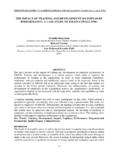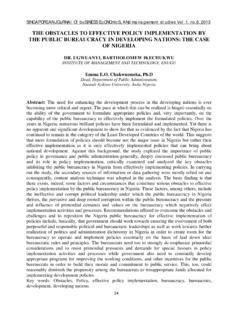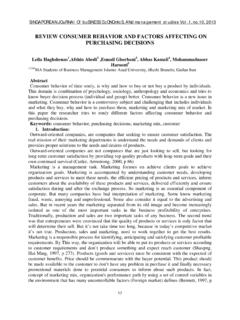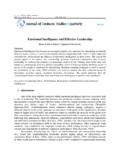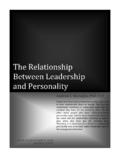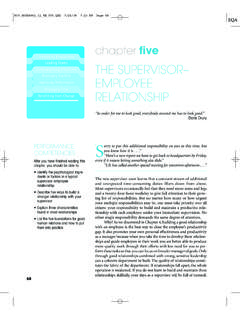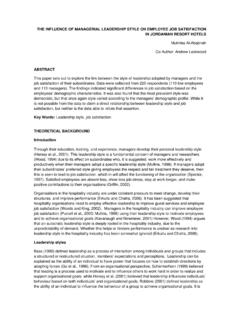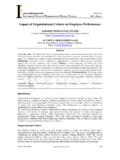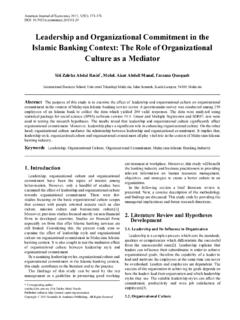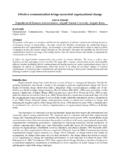Transcription of THE RELATIONSHIP BETWEEN LEADERSHIP STYLE …
1 , 20135 SINGAPOREAN JOuRNAl Of buSINESS EcONOmIcS, ANd mANAGEmENt StudIES , NO. 21 THE RELATIONSHIP BETWEEN LEADERSHIP STYLE AND employee PERFORMANCE (Case Study of Real Estate Registration Organization of Tehran Province) Bizhan Shafie Department of Public Management, Islamic Azad University, Rasht Branch, Rasht, Iran Saeid Baghersalimi Department of Public Management, Islamic Azad University, Rasht Branch, Rasht, Iran Vahid Barghi of Business Management, Islamic Azad University, Rasht Branch, Rasht, Iran (Corresponding Author) Abstract The aim of this study was to determine the RELATIONSHIP BETWEEN LEADERSHIP STYLE and employees performance in the Real Estate Registration in Tehran province.
2 This research used descriptive correlation method. The study population comprised all staff in Tehran Real Estate Registration with 1000 number. Cochran method was used to determine the sample size and the sample number was calculated 277 one. Simple random sampling is used in this research. Data collection instruments included two questionnaires of LEADERSHIP STYLE and employees performance. To test the hypotheses, correlation method using SPSS software was used. And the results showed that development-oriented and pragmatic- oriented LEADERSHIP STYLE has a positive impact on employee performance and LEADERSHIP STYLE and non-interference is a negative impact.
3 Keywords: LEADERSHIP styles , employee performance Introduction In today's society, flow of life depends on the organizations and development and survival of community, work function and effective performance. Organizations have been established to address social needs and group activities. The main drivers of organizations are humans. They give life to the organizations and provide goals. So, human development and efforts and their lead to the attainment of the objectives is not possible without management. Since the first principle of organization is the presence of human, obviously the most basic step that must be done to accomplish this is to maintain personnel and provides the psychological satisfaction and fulfillment of employees.
4 Throughout human history, always the developments and changes made by individuals and groups associated with the presence of a person as a leader. These actions have been undertaken under his guidance. Throughout history, LEADERSHIP has been one of the pillars of human societies. When LEADERSHIP is considered as a function, is an important component of management. And his presence and , 20135 SINGAPOREAN JOuRNAl Of buSINESS EcONOmIcS, ANd mANAGEmENt StudIES , NO. 22 the existence in the group is consider as a number of skills that these skills can be seen as a means or styles of LEADERSHIP to achieve certain goals (Bennett & Anderson, 2003).
5 Leaders by take the necessary measures and establish human relationships to provide optimal use of human resources in their organization that among these measures we can refer to take correct LEADERSHIP STYLE . Obviously, every manager in their management and operations uses a particular LEADERSHIP STYLE that this STYLE is actually a set of his behavior patterns that frequently occurs during the constant organizational working and others knows him by it and as managers of the organization are in very cooperation with the staff, the LEADERSHIP STYLE of these managers has a significant impact on staff morale.
6 And consequently, the staff morale will affect on their performance (Shirzad & Kebriya & Zanganeh, 2011). In fact, LEADERSHIP is important for all organizations to achieve goals. Since LEADERSHIP is a key factor for improving the performance of the organization, the success or failure of an organization depends on the effectiveness of LEADERSHIP at all levels. Researchers have stated that LEADERSHIP is an ability to influence attitudes, beliefs, and abilities of employees to achieve organizational goals. However, over the years, LEADERSHIP has been had a major topic BETWEEN the researchers but dramatic social changes that have occurred over the past two decades makes the issue of LEADERSHIP and its RELATIONSHIP with other organizational factors more remarkable (Duckett & Macfarlane, 2003).
7 Transformational LEADERSHIP STYLE in new ideas is known as one of the effectiveness LEADERSHIP STYLE . The STYLE has been composed of four dimensions of ideals influence, inspirational motivation, intellectual stimulation and individualized consideration (Storey, 2004). In fact, all of transformational LEADERSHIP behavior (individualized consideration, inspiration, intellectual stimulation and charisma) that provide high-performance and active LEADERSHIP has positive and high impact on employee satisfaction and improvement of organization situation (Hoy & Miskel, 2008).
8 The study also sought to examine the RELATIONSHIP BETWEEN LEADERSHIP styles on the organization employee performance. Among the different styles of LEADERSHIP , development-oriented and pragmatic- oriented STYLE has been most interest to researchers. Transformational-oriented LEADERSHIP and pragmatic-oriented LEADERSHIP are not two contradictory theories, rather they are complementary ideologies as both are introduced the Supreme LEADERSHIP forms (Stone Et al. 2004). But the two concepts are some different with each other. While both pragmatic-oriented and transformational-oriented LEADERSHIP are emphasized on the influence and impacts, pragmatic-oriented is achieved to this effect by non-traditional ways that is being in the position to serve.
9 Pragmatic- oriented LEADERSHIP is greater emphasis on serving to followers and also is shown more confidence and freedom to subordinates. Transformational LEADERSHIP is more emphasis on organizational goals, while servant LEADERSHIP are emphasized and focused on the people who followed him (Stone Et al. 2004). In the model of pragmatic LEADERSHIP , leader motivation for LEADERSHIP comes from the felt of equality BETWEEN the leaders and subordinates. In other words, the belief system of the leader will force him to know himself on equal par with those leads. That is all members of the organization have equal and the same law, information and perspective and the role of the leader is facilitating the formation of the organization (Duckett & Macfarlane, 2003).
10 Pragmatic LEADERSHIP as transformational LEADERSHIP with organizational mechanisms such as compensation, communication, organizational policies and procedures and methods create , 20135 SINGAPOREAN JOuRNAl Of buSINESS EcONOmIcS, ANd mANAGEmENt StudIES , NO. 23 psychological productive culture with spiritual, personal, productive, passive characteristics and tend to maintain the status quo that this culture makes that pragmatic LEADERSHIP served more successful in the constant environments and in the in dynamic environments act more failure than transformational LEADERSHIP and make appropriate this STYLE of LEADERSHIP for the period of peace and stability in the organization.
